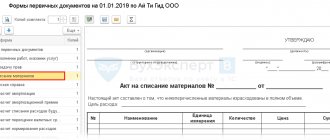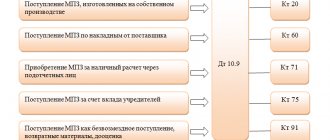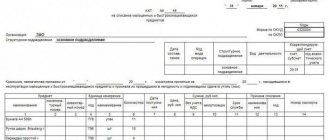Components and parts of cars used by the enterprise to carry out business activities from time to time become unusable - they wear out. Driving a car with a set of problematic auto parts becomes dangerous. Therefore, damaged mechanisms must be replaced in a timely manner, and this must be done correctly, from the point of view of the law.
To start the process of writing off new parts for repair, the so-called Act of writing off spare parts for a car is initially drawn up.
Legal side
New car parts that are purchased to replace old ones are initially placed on the balance sheet of the enterprise and, when replacing worn ones, are written off for car repairs.
A corresponding document (write-off act) is drawn up to accompany this process. There is no mandatory form, but it is required to be drawn up by Law 402-FZ “On Accounting”, where the second part of Article 9 contains a list of what details must be indicated in the document.
The form of the act with which auto parts will be written off is attached to the accounting policy of the organization.
Shelf life – 5 years. The paper is drawn up in two copies, one of which is located in the storage or operation areas, the other in the accounting department.
Disposal of car tires and batteries
During operation, car tires and batteries become unusable, they become dangerous for use and must be replaced. New spare parts issued for use to replace worn-out ones are accounted for in off-balance sheet account 09 “Spare parts for vehicles issued to replace worn-out ones.” There is no regulatory act establishing the standard for the operation of tires and batteries. The article provides recommendations for establishing in the accounting policy methods for determining the standard of operation of these spare parts, and examines the actions of an accountant when writing off tires and batteries that are unsuitable for further use from accounting accounts.
Tires and batteries have a certain service life - standard. To determine this period, taking into account a number of features, you should be guided by:
– Federal Law of December 10, 1995 No. 196-FZ “On Road Traffic Safety”;
– standards for the service life of automobile tires in accordance with the Temporary standards for the service life of vehicle tires (RD 3112199-1085-02), approved by the Ministry of Transport of the Russian Federation on 04.04.2002 (hereinafter referred to as the Temporary Standards);
– Methodological guidelines for determining the cost of vehicles, taking into account natural wear and tear and technical condition at the time of presentation (approved by the Ministry of Economy of the Russian Federation 04.06.1998 RD 37.009.015-98) (hereinafter referred to as the Methodological Guide RD 37.009.015-98);
– Rules for establishing the amount of costs for materials and spare parts for the restoration of vehicles, approved by Decree of the Government of the Russian Federation of May 24, 2010 No. 361 (hereinafter referred to as Rules No. 361).
Standards for using car tires
According to the provisions of Art. 19 of Federal Law No. 169-FZ prohibits the operation of vehicles if they have technical faults that pose a threat to road safety. The list of vehicle malfunctions and the conditions under which their operation is prohibited are determined by Decree of the Government of the Russian Federation of October 23, 1993 No. 1090 . Section 5 of this list contains a list of damage to car tires in which the car cannot be operated. Among these damages are:
- the residual tread height of passenger car tires is less than 1.6 mm, trucks – 1 mm, buses – 2 mm, motorcycles and mopeds – 0.8 mm[1];
- the presence of external damage to the tires (punctures, cuts, breaks) exposing the cord, as well as delamination of the carcass, peeling of the tread and sidewall;
- the absence of a fastening bolt (nut) or the presence of cracks in the disk and wheel rims, the presence of visible irregularities in the shape and size of the mounting holes.
Thus, these damages are grounds for removing tires from service, installing new ones instead, and, accordingly, reflecting these operations in accounting accounts.
The degree of wear of the tread pattern also depends on the mileage of the tires. Traveling a certain number of kilometers by a car can also be grounds for stopping operation and writing off tires from accounting accounts.
Until January 1, 2007, the formula given in the Temporary Standards was used to calculate the standard tire mileage. From this date, the validity of the Temporary Norms expired ( Order of the Ministry of Transport of the Russian Federation dated January 5, 2004 No. AK-1-r ), at the same time, by order of the founder, the institution has the right to use their provisions. For example, Order of the Judicial Department under the RF Armed Forces of June 30, 2008 No. 104 (as amended on February 14, 2011) (hereinafter referred to as Order of the SD under the RF Armed Forces No. 104) determined that in order to streamline the operation of official vehicles and organize motor transport support for the activities of courts of general jurisdiction, the Judicial Department under the Armed Forces of the Russian Federation and departments (divisions) of the Judicial Department in the constituent entities of the Russian Federation, when operating vehicles, one should be guided, among other things, by the Temporary Standards. If the founder has not made such a decision regarding your budget-funded institution, you have the right in your accounting policies to establish a formula for determining the standard operating mileage of tires used in the institution, guided by the Temporary Standards.
So, in the annex to the accounting policy, based on the information given in table. 1 – 9 Temporary Standards , you can set the average tire mileage, taking into account correction factors that depend on operating conditions. If there is no information in the Temporary Standards for vehicles operated by an institution, the institution establishes the operating mileage standard independently.
Example 1
On the balance sheet of the institution there is a Toyota car, which is assigned 2 sets of tires - summer and winter (195/70R14) (accounted for in off-balance sheet account 09). The budgetary institution, guided by the Temporary Standards, established the following in its accounting policies.
The tire mileage rate (Hi) is calculated using the following formula:
| Hi | = H x K1 | x K2, where: |
H – average tire mileage, thousand km (the value is given in the appendix to the accounting policy);
K1 – correction factor taking into account the category of operating conditions of the vehicle (the value is given in the appendix to the accounting policy);
K2 is a correction factor that takes into account the operating conditions of the vehicle.
When writing off tires, their operational mileage rate should not be lower than 25% of the average mileage (exceptions are mechanical damage to tires that cannot be eliminated and which prevents their further operation).
K1 = 0.95 (the car is driven in the city); K2 = 0.95.
The average mileage of tires with parameters 195/70R14 for a Toyota car is 50,000 km.
During operation, summer tires became unusable. According to the waybills, it was established that their mileage was 48,200 km.
The standard tire mileage is 45,125 km (50,000 km x 0.95 x 0.95). A set of summer tires has passed the operating norm established for it and is subject to write-off.
As another way to determine tire wear, we can recommend the method given in Appendix 15 to the Methodological Guide RD 37.009.015-98. This manual defines the methods and procedure for calculating the cost of a vehicle, taking into account its technical condition, completeness and additional equipment; natural and moral wear and tear, aging; the cost of spare parts, work and materials necessary to restore it to a state that meets the general technical and safety requirements regulated by current legislation.
This method for determining tire wear is based on the following.
Tire wear (aging) criteria are:
– presence of damage and defects;
- lifetime;
– tread pattern height.
The tire life is reduced and, accordingly, the percentage of wear increases:
– if the board is damaged during installation – up to 10%;
– if spalling, chips, cracks on the tread or cracks and wear of the sidewall without exposing the cord are detected – up to 20%;
– if local wear (spotting) of the tread is detected – up to 25%.
Note: tires with carcass delamination are considered 100% worn.
To the percentage of wear determined by technical condition, the percentage of wear (aging) over the service life of the tire is added .
Over three years of operation, a tire loses up to 10% of its service life due to aging in proportion to its service life.
In the interval from three to five years, tire aging increases to 25%. A tire with a service life of more than five years can reach an estimated wear rate of 50%.
The service life is determined by the date of manufacture in accordance with the factory marking in accordance with GOST 4754-80.
The tire tread life is characterized by its height on a new tire (Vn) (shown in the table contained in Appendix 15 to the Methodological Guide RD 37.009.015-98) minus the minimum permissible residual tread height (Vdop), at which the tire must be removed from service ( for passenger car tires - 1.6 mm, for trucks - 1 mm, buses - 2 mm, motorcycle tires - 0.8 mm).
The residual (actual) height of the tire tread pattern (Vph) is determined as the arithmetic mean of the heights measured in four mutually perpendicular sections of the tire around the circumference. It is more expedient to make such measurements in the planes of the natural symmetry of the wheel. In each section, the height of the pattern is determined by the area of the treadmill that has the maximum wear.
The percentage of tire wear by tread height is calculated using the formula:
| Ish = | (Vn - Vf) | x 100%. |
| (Vn - Vdop) |
The wear of tires retreaded by applying a new tread is determined by the method described above, while the nominal height of the retread pattern is taken to be 10 mm for passenger cars, 20 mm for trucks and buses, and the average cost of a retreaded tire is equal to the cost of refurbishment plus a deposit the cost of a tire to be retreaded, which is on average 0.2% of the cost of a new tire.
This method of determining the service life of tires is more accurate and objective, although more labor-intensive. The difficulty of its application lies in measuring the height of the tread pattern in four sections of the tread size. When using this method, the accounting policy of the institution can set the amount of wear determined by calculation, at which the tires are subject to write-off. For example, this value could be 90 or 100%.
Having clarified the conditions of example 1, we will calculate the wear of summer tires on a Toyota car using the second method.
Example 2
The service life of a 195/70R14 Toyota tire is 2 years. There is damage to the side during installation. Measuring the tread pattern height in four sections showed that the actual tread height is 4.3 mm (4.5 + 4.4 + 4.0 + 4.3) / 4.0).
Damage to the bead during installation reduces the tire life by 10%. The service life (2 years) of the tire increases wear by another 7% (in proportion to the service life from 10%).
Tire wear along the tread pattern height is 61% ((8.6 - 4.3) / (8.6 - 1.6) x 100%).
The total wear is 78% (10 + 7 + 61).
Thus, according to the second calculation option, the possibility of writing off these tires will arise only if the accounting policy determines that tires for which the wear rate is 75% or higher are subject to write-off. If the accounting policy of the institution establishes, for example, that “tires with an estimated wear rate of 90% or more are subject to write-off,” tires with an estimated wear rate of 78% remain in service (with the exception of mechanical damage that makes it impossible to further operate the tires) .
Standard service life of car batteries
The battery has a certain service life. There is no universal regulation establishing the service life of batteries in vehicles used by institutions. Order of the SD under the Supreme Court of the Russian Federation No. 104, which we mentioned earlier, refers the departments of the judicial department, when establishing the standard service life of the battery, to the Service Life Standards for Starter Batteries of Motor Vehicles in accordance with the guidance document of the Ministry of Transport of the Russian Federation “Service Life Standards for Starter Lead-Acid Batteries vehicles and forklifts" (RD-3112199-1089-02) (hereinafter referred to as Battery Life Standards). These standards are intended for use by owners of vehicles and forklifts when determining when to write off starter lead-acid batteries.
If your founder does not give clear recommendations regarding the document that should be followed when determining the operating life of the battery (including the battery life is not established by the internal document [2]), then in your accounting policy you can specify these standards (or refer to the document defining them, which you will use in your work).
For example, the accounting policy may state: “The service life of starter lead-acid batteries of vehicles on the balance sheet of the institution is determined according to the standards developed by the Federal State Unitary Enterprise “State Scientific Research Institute of Automobile Transport” (NIIAT) (RD- 3112199-1089-02) (hereinafter referred to as Standards RD-3112199-1089-02), or “The service life of starter lead-acid batteries of vehicles owned by an institution is determined according to the methodology given in Appendix 16 to the Methodological Guide RD 37.009 .015-98, or “The service life of starter lead-acid batteries of vehicles owned by an institution is determined by Rules No. 361.
Let's assume that the vehicles on your company's books have lead-acid starter batteries. The institution decided to determine the standard service life in accordance with Standards RD-3112199-1089-02, and this was reflected in the accounting policy. Using the data reflected in Table 1 of Norm RD-3112199-1089-02, the typical battery life should be determined, based on which the shelf life of the battery in use is determined. For a passenger car used for business purposes with an annual mileage of 112,000 km, the standard is 2.5 years (information is given in Table 1). Let's assume that the annual mileage of the vehicles you use is less than the established size (let it be 90,000 km), but corresponds to the average annual mileage, if exceeded, it is recommended to adjust the standard mileage standards. This value is shown in Table 2 and for passenger cars used for official purposes is 45,000 km. Since the actual annual mileage of the vehicle exceeds 45,000 km, the battery usage rate may be adjusted. As a result of the adjustment, the service life of the battery can be increased to four years. The accounting policy may immediately establish an adjusted norm or may specify the conditions under which the norm is adjusted and indicate the persons responsible for this.
To confirm the fact that the battery has reached the established standard service life, it is advisable for officials responsible for the operation of vehicles to organize a record of the operating time and results of servicing the battery from its commissioning to decommissioning. The operating time of a battery is taken into account in the same units as the vehicles equipped with it, that is, in kilometers or engine hours of operation with this battery. When using rechargeable batteries on different vehicles, the sum of the mileage of these vehicles with a given battery must be taken into account. In addition to operating hours, maintenance work performed and the results of charging the battery after performing this work are subject to recording.
Accounting for operating time and charging results during operation of starter batteries can be carried out in the form given in Appendix 2 to Standards RD-3112199-1089-02, or in a form convenient for the institution for accounting for the use of a battery developed and approved in the accounting policy.
The technology for identifying faults, in the presence of which it is possible to write off starter lead-acid batteries, is given in Appendix 1 to Standards RD-3112199-1089-02.
Appendix 16 to the Methodological Guide RD 37.009.015-98 offers a method for determining the percentage of battery wear. The technique is as follows.
Battery wear (Iacb) is determined as the ratio of the actual operating time of the presented battery (Df) to the average service life (Dst) before its replacement (disposal), that is, according to the following formula:
| Iakb = | Df | x 100% |
| Dst |
The battery life (average resource) is obtained using mathematical processing of statistical data and is determined regardless of the type:
– three years – with a vehicle operating intensity of 40 thousand km per year or more;
– in four years – with an operating intensity of up to 40 thousand km per year.
The actual service life of the battery is determined as the difference between the date of inspection of the presented vehicle and the date of its manufacture.
The date of manufacture is determined by the marking on the battery, the type and method of application of which are established by the regulatory document for the manufacture of a specific type [3], brand of battery.
Reflection of write-off transactions in accounting
According to the norms of paragraph 349 of Instruction No. 157n [4], off-balance sheet account 09 “Spare parts for vehicles issued in replacement of worn-out ones” takes into account material assets issued for vehicles in replacement of worn-out ones. The list of material assets recorded on the off-balance sheet account (engines, batteries, tires, etc.) is established by the accounting policy of the institution.
Material assets are reflected in off-balance sheet accounting at the time of their disposal from the balance sheet account for the purpose of repairing vehicles and are taken into account during the period of their operation (use) as part of the vehicle. The disposal of material assets from off-balance sheet accounting is carried out on the basis of an acceptance certificate for completed work, confirming their replacement. In our opinion, the write-off of tires and batteries from off-balance sheet accounting should be carried out on the basis of the Act on the write-off of inventories (f. 0504230), since this document is used to formalize the decision to write off inventories and serves as the basis for reflecting in the accounting records of the institution the disposal from the accounts of the accounting inventory accounting (Appendix 5 to Order of the Ministry of Finance of the Russian Federation No. 173n [5]).
In accounting, the installation of spare parts for a car to replace worn-out ones and the write-off of the latter are reflected as follows:
| Contents of operation | Debit | Credit | A document base | Paragraph Instructions No. 157n |
| Tires and batteries installed on the vehicle to replace worn ones are reflected in the accounting | 09 | Request-invoice (f. 0315006), Statement of issue of material assets for the needs of the institution (f. 0504210) | 349 | |
| Used tires and battery written off | 09 | Act on write-off of inventories (f. 0504230), acceptance certificate of work performed |
In conclusion, I would like to draw the attention of readers to the following. Lead-acid batteries, whole or broken (AA170), are classified as waste containing metals and must be disposed of (Waste nomenclature (in accordance with OECD resolution) “GOST R 53691-2009. National standard of the Russian Federation. Resource conservation. Waste management. Passport waste of I - IV hazard classes. Basic requirements "(approved and put into effect by Order of Rostekhregulirovanie dated December 15, 2009 No. 1091-st ). According to Article 1 of the Federal Law dated June 24, 1998 No. 89-FZ "On production and consumption waste" ( hereinafter referred to as the Law on Production and Consumption Waste), production and consumption waste refers to the remains of raw materials, materials, semi-finished products, other items or products that were formed in the process of production or consumption, as well as goods (products) that have lost their consumer properties. This law establishes requirements and responsibilities in the field of industrial and consumer waste management, which apply both to business entities whose activities generate waste, and to persons carrying out activities in the field of waste management.
Consequently, a person whose production activities generate waste is obliged to comply with the requirements of the Law on Industrial and Consumer Waste, as well as environmental and sanitary-epidemiological requirements provided for by current legislation.
According to Art. 22 of the Federal Law of March 30, 1999 No. 52-FZ “On the sanitary and epidemiological welfare of the population”, production and consumption waste is subject to collection, use, neutralization, transportation, storage and burial, the conditions and methods of which must be safe for public health and the environment and which must be carried out in accordance with sanitary rules and other regulatory legal acts of the Russian Federation.
Clause 3.7 C of the sanitary and epidemiological rules and regulations SanPiN 2.1.7.1322-03 , put into effect on June 15, 2003 by Decree of the Chief State Sanitary Doctor of the Russian Federation dated April 30, 2003 No. 80 , it is established that during temporary storage of waste in non-stationary warehouses, in open areas without containers (in bulk, in bulk) or in unsealed containers, the surface of waste stored in bulk or open receptacles must be protected from the effects of precipitation and winds (covering with tarpaulin, equipment with a canopy, etc.), embankment and embankment must be provided along the perimeter of the site a separate network of storm drains with autonomous treatment facilities.
By virtue of paragraphs 2 and 3 of Art. 14 of the Law on Production and Consumption Waste , business entities whose activities generate waste of hazard classes I–IV are required to confirm the classification of these wastes into a specific hazard class in the manner established by the federal executive body that carries out state regulation in the field of environmental protection. For waste of hazard classes I – IV, a passport is drawn up based on data on the composition and properties of this waste, assessment of its danger ( Resolution of the Presidium of the Supreme Arbitration Court of the Russian Federation dated July 12, 2011 No. 709/11 No. A32-10488/2010-58/157-58 ).
Article 8.2 of the Code of Administrative Offenses of the Russian Federation establishes that failure to comply with environmental and sanitary-epidemiological requirements when collecting, accumulating, using, neutralizing, transporting, disposing and otherwise handling industrial and consumer waste or other hazardous substances entails the imposition of an administrative fine on officials - from 10,000 to RUB 30,000; for legal entities – from 100,000 to 250,000 rubles. or administrative suspension of activities for up to 90 days.
Thus, in order to avoid various unpleasant situations, we recommend that you immediately transfer the batteries for disposal to a specialized organization.
_____________________________
[1] For trailers, standards for the residual height of the tire tread pattern are established, similar to the standards for tires of vehicles - tractors.
[2] For example, as was done in the Order of the Federal Penitentiary Service of the Russian Federation dated April 18, 2005 No. 268 “On approval of standard work periods before major repairs and write-off of automobile, road construction equipment and electrical equipment, frequency of technical maintenance of motor vehicles of the federal budgetary institution “Motor Transport Administration” Federal Penitentiary Service" and the procedure for storing and conserving motor vehicles, machine tools and park equipment."
[3] There are currently three types of battery in use:
1. Monoblock with cellular covers and jumpers over the covers (old design).
2. Monoblock with a common cover and jumpers filled with mastic.
3. Monoblock (plastic case) with a common cover - maintenance-free battery.
[4] Order of the Ministry of Finance of the Russian Federation dated December 1, 2010 No. 157n “On approval of the Unified Chart of Accounts for public authorities (state bodies), local governments, management bodies of state extra-budgetary funds, state academies of sciences, state (municipal) institutions and Instructions on its use."
[5] Order of the Ministry of Finance of the Russian Federation dated December 15, 2010 No. 173n “On approval of forms of primary accounting documents and accounting registers used by public authorities (state bodies), local governments, management bodies of state extra-budgetary funds, state academies of sciences, state (municipal ) institutions, and guidelines for their use."
Hello Guest! Offer from "Clerk"
Online professional retraining “Accountant on the simplified tax system” with a diploma for 250 academic hours . Learn everything new to avoid mistakes. Online training for 2 months, the stream starts on March 1.
Sign up
Who, when and on what basis draws up
The initiator of the write-off of vehicle spare parts is the financially responsible person. Most often this is a driver or mechanic. The algorithm of actions is as follows:
- MOL writes a memo to the director;
- a specially appointed commission of technical specialists draws up a defective list indicating the spare parts (those to be repaired) that need to be replaced;
- the manager issues an order;
- a write-off act is drawn up, signed, and approved by the manager;
- The document is sent to the accounting department.
Based on the act, spare parts are written off from the financially responsible person.
Accounting for spare parts and assemblies
Spare parts for the car are accounted for in subaccount 10-5 “Spare parts”.
If spare parts are purchased from a third party, then the following entries are made in accounting:
Debit 10-5 Credit 60
Debit 19-3 Credit 60
— reflects the amount of VAT on purchased spare parts.
When a spare part or part, assembly or unit is transferred from a warehouse for installation on a vehicle, an entry is made in the accounting records:
Debit 20, 23, 25, 26, 44… Credit 10-5
— the cost of a spare part, unit, component or unit installed in place of a removed unit during repair work is written off.
The costs of replacing worn-out parts of a car are the costs of ongoing repairs, which are included in the cost of products, works, and services as the costs of maintaining fixed production assets in working order. However, there is no provision for rationing of these expenses.
Rules for compilation and design
In the upper right corner is written the word “I approve”, the position of the manager, his last name and initials. Further:
- document name, number, date;
- the structural unit in charge of the vehicle must be indicated;
- the place where the act is drawn up is indicated;
- the basis is written;
- name of each part, number of pieces and cost;
- Below are the signatures of the commission members, their positions and full names.
The accounting department will accept the act only after approval by the manager. There is no stamp on the spare parts write-off act.
Why do you need a spare parts write-off act?
Enterprises that use cars regularly record transactions that reflect the turnover of spare parts for them. In this case, it is assumed that the following basic operations with these materials are recorded:
- Posting.
- Moving from one division of the company to another.
- Write-off for repair.
Each case uses its own supporting documents. If we talk about the 3rd operation, then as a corresponding document, many companies use an independently developed form of an act of writing off spare parts for a car, the main feature of which is the justification for the need to replace the corresponding spare part.
This act can be used as an alternative to such unified forms as an invoice (drawn up according to the M-15 form) or a demand invoice (drawn up according to the M-11 form), which do not always meet the specifics of the movement of spare parts accepted in the organization when writing off for repairs.
M-11 and M-15 are unified forms reflecting the release of goods and materials from the warehouse (clause 100 of the Methodological Instructions, approved by Order of the Ministry of Finance of the Russian Federation dated December 28, 2001 No. 119n). At the same time, the act of writing off for repairs can formalize the transfer of inventory items not only from the warehouse, but also between divisions of the company.
Read about forms M-11 and M-15 in the articles:
Step-by-step filling
| Part | Description |
| Upper | Abbreviated name of the organization. For example, MostProm LLC. The structural unit can be a “workshop”, “garage”, etc. |
| Descriptive | At the beginning of the act, the composition of the commission is listed. “A commission consisting of chief accountant I.N. Pashkova, and members of the commission - accountant N.V. Yuryeva. and senior mechanic Prokhorov I.P. drew up a real act in that...” Indications of the need for replacement are taken from the conclusion of a car service center, or a defective statement, which indicates that worn-out spare parts are not subject to further use and repair, and also states the reason for which such a conclusion was made. Next, it is indicated which spare parts should be written off with the exact name, as they are listed according to the documents in the accounting department. It is more convenient to do this in the form of a table, especially if several units are written off at the same time. It indicates the name of each spare part, quantity, if several identical ones are written off, price and line amount. |
| Lower | Members of the commission endorse the correctness of the documents. |
What else…
If the company independently develops the form, then it can be immediately drawn up on company letterhead, then there will be no need to enter the name. The same applies to the members of the commission: if it is permanent, then in the text “The commission consists of...” and at the bottom, where the signatures are placed, the members of the commission can be immediately entered, indicating their positions and full names.
If spare parts are written off that can be sold for scrap or used for other purposes, this is also indicated in the document and serves as the basis for accounting for registration in a new capacity.
The act for writing off automobile spare parts is filled out in duplicate and submitted to the manager for approval.
TRUDKO, INFO







